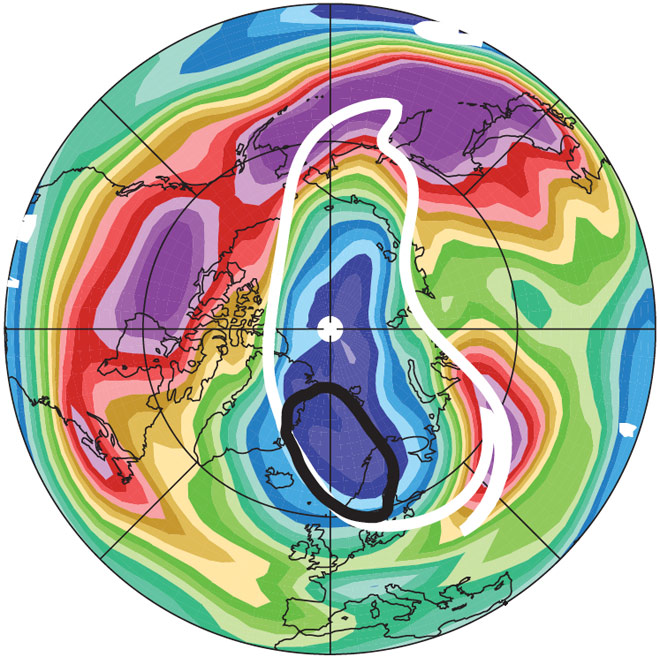Science News
Arctic Ozone Hole
October 4, 2011
0

A NASA study marks bad news for the ozone layer above the Arctic. For a few months this past winter and spring, there was an unprecedented 80% ozone loss, extending from about 10 to 20 miles (15 to 35 kilometers) above the surface in the area.
From New Scientist:
“The loss in 2011 was twice that in the two previous record-setting Arctic winters, 1996 and 2005,” says Nathaniel Livesey of the Jet Propulsion Laboratory in Pasadena, California.
The study, published this week in the journal Nature, finds the amount of ozone destroyed in the Arctic in 2011 was comparable to that seen in some years in the Antarctic, where an ozone hole has formed each spring since the mid-1980s. The stratospheric ozone layer protects life on Earth from the sun's harmful ultraviolet rays.
The Antarctic ozone hole forms when extremely cold conditions, common in the winter Antarctic stratosphere, trigger reactions that convert atmospheric chlorine from human-produced chemicals into forms that destroy ozone. The same ozone-loss processes occur each winter in the Arctic. However, the generally warmer stratospheric conditions there limit the area affected, resulting in far less ozone loss in most years in the Arctic than in the Antarctic.
To investigate the 2011 Arctic ozone loss, scientists from 19 institutions in nine countries (United States, Germany, The Netherlands, Canada, Russia, Finland, Denmark, Japan and Spain) analyzed a comprehensive set of measurements. These included daily global observations of trace gases and clouds from NASA's Aura and CALIPSO spacecraft; ozone measured by instrumented balloons; meteorological data and atmospheric models. The scientists found that at some altitudes, the cold period in the Arctic lasted more than 30 days longer in 2011 than in any previously studied Arctic winter, leading to the unprecedented ozone loss. Further studies are needed to determine what factors caused the cold period to last so long.
“Day-to-day temperatures in the 2010-11 Arctic winter did not reach lower values than in previous cold Arctic winters,” said lead author Gloria Manney of NASA's Jet Propulsion Laboratory. “The difference from previous winters is that temperatures were low enough to produce ozone-destroying forms of chlorine for a much longer time. This implies that if winter Arctic stratospheric temperatures drop just slightly in the future, for example as a result of climate change, then severe Arctic ozone loss may occur more frequently.”
New Scientist reports that
Climate change could be partly responsible. That may seem counter-intuitive, but global warming occurs only at the bottom of the atmosphere. "Climate change warms the surface but cools the stratosphere," [University of Cambridge’s Neil] Harris explains.
Image: Gloria L. Manney et al./Nature
0